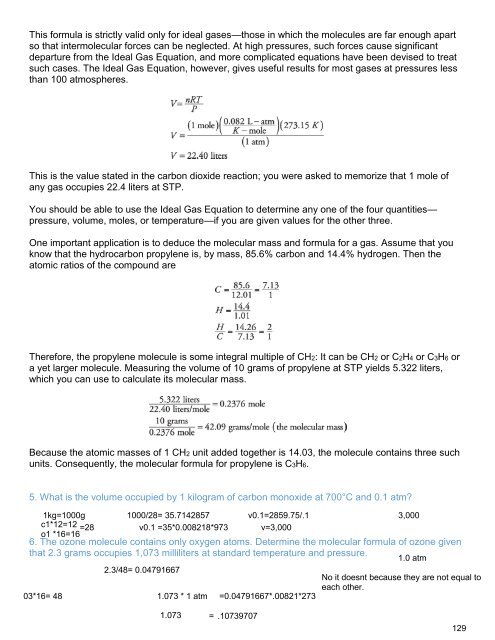You also want an ePaper? Increase the reach of your titles
YUMPU automatically turns print PDFs into web optimized ePapers that Google loves.
Then substitute them into the constant ratio of Charles' law:<br />
When using Charles' law, remember that volume and Kelvin temperature vary directly; therefore, an<br />
increase in either requires a proportional increase in the other.<br />
2. A gas occupying 660 ml at a laboratory temperature of 20°C was refrigerated until it shrank to 125<br />
ml. What is the temperature in degrees Celsius of the chilled gas?<br />
660/20c = 125ml/t<br />
+273<br />
660ml/293 = 125/t<br />
Gay-Lussac's Law<br />
36625=660t<br />
t=55.4924<br />
-273<br />
t=218.494<br />
p =200c<br />
-200 C<br />
This relationship between temperature and pressure is known as Gay-Lussac's law. It states that if<br />
the volume of a container is held constant as the temperature of a gas increases, the pressure inside<br />
the container will also increase. As with the other gas laws, this one can be represented in the form of<br />
an equation:<br />
P1 = P2<br />
T2<br />
Recall that we use 1s and 2s to indicate the quantities before (1s) and after (2s) a change has taken<br />
place. Also, note that the units for pressure do not matter, as long as they are the same throughout<br />
the entire equation. The units for temperature must be Kelvins or the equation will not work. This is<br />
because the Kelvin scale is an absolute scale - it doesn't go negative. <strong>Final</strong>ly, this equation only<br />
works for an ideal gas. Most gases that surround you and me behave very much like ideal gases, so<br />
we can use this equation as an approximation for the gases we encounter.<br />
T2<br />
126



